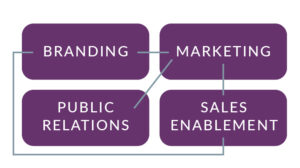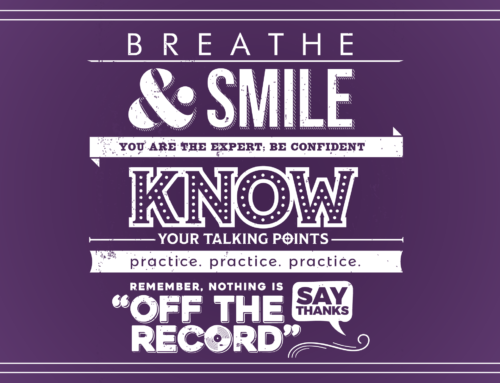These four areas provide a foundation for marketing success
A car with a flat tire won’t move forward – even if the other three tires are in perfect condition. It’s the same with a marketing approach. A business may have a strong marketing plan, but an outdated brand identity; or a stellar PR strategy, but no sales enablement process to move business through the funnel. A marketing success matrix connects four key areas of marketing to provide your business with a strong foundation for growth, profitability, brand health, and more.
Branding, marketing, PR (public relations), and sales enablement are all integral components of a comprehensive business strategy. Each of these elements uniquely builds a strong market presence, drives customer engagement, and ultimately boosts sales.
Branding: Branding is the process of creating a distinct and memorable identity for your business, product, or service in the minds of your target audience. It involves defining your company’s values, mission, vision, and unique selling propositions. A well-crafted brand can help establish emotional connections with customers, enhance credibility, and differentiate you from competitors.
Marketing: Marketing encompasses a range of activities aimed at promoting your products or services to a target audience. This can include market research, advertising, digital marketing, content creation, social media engagement, and more. Effective marketing strategies ensure that your brand message reaches the right people through the right channels, driving interest and demand.
Public Relations: PR focuses on managing and cultivating relationships between your business and the public, including customers, media, investors, and other stakeholders. PR efforts aim to create positive perceptions and manage the reputation of the brand. It involves activities such as media relations, press releases, crisis communication, event management, and thought leadership.
Sales Enablement: Sales enablement refers to the tools, resources, and processes provided to the sales team to help them effectively engage with potential customers and close deals. This can include pitch decks, sales collateral, customer personas, and CRM platforms that aid sales activities. Sales enablement aligns the sales process with the overall brand message and marketing strategies.
These elements are interconnected and work together to create a cohesive business strategy:
BRANDING AND MARKETING:
A strong brand provides the basis for all marketing efforts. Without it, a marketing approach can become a series of unrelated tactics with no consistency in messaging, design, or tone, and customers are less likely to understand your brand or engage in your business.
MARKETING AND PR:
Marketing activities create awareness and demand, while PR helps to build credibility and manage the public’s perception. PR efforts can amplify marketing campaigns through media coverage and endorsements, enhancing a brand’s reputation.
MARKETING AND SALES ENABLEMENT:
Marketing provides the leads and interest that the sales team can then convert into customers. Sales enablement equips the sales team with the necessary tools and knowledge to effectively communicate the brand’s value and close deals.
BRANDING AND SALES ENABLEMENT:
A clear brand identity helps salespeople present a consistent and compelling message to potential customers. Sales enablement materials, such as pitch decks and case studies, should reflect the brand’s values and resonate with the target audience.
Successful businesses integrate branding, marketing, PR, and sales enablement into a unified strategy. The marketing success matrix approach ensures that all aspects of the business work harmoniously to create a strong market presence, foster customer relationships, and drive revenue growth.
Want to fix a “flat tire” in your marketing plan? Reach out to Winger Marketing here for a complimentary consultation.










